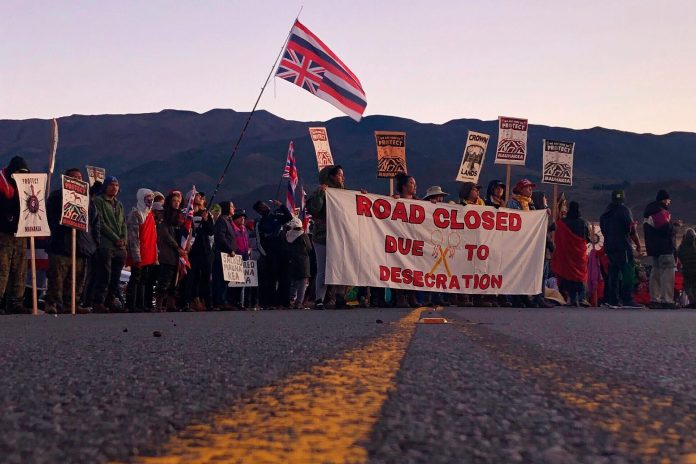Ariel Andres
Staff Writer
In early November, an email campaign was launched asking the University of California (UC) Board of Regents to divest from the construction of the Thirty Meter Telescope (TMT) on Mt. Mauna Kea, Hawaii.
The email template used for the campaign notes several grievances, such as the construction of the TMT would desecrate land sacred to the Kanaka Maoli Native Hawaiians, as well as how it would disrupt the environment and ecosystem by potentially contaminating the water supply and hurting the mountain’s already fragile fauna and flora.
The campaign is part of a seven-year struggle to prevent the construction of the TMT, which was announced in 2014 when the TMT International Observatory LLC (TIO) — the group that oversees the TMT and selected Mauna Kea as its final choice for construction.
Kealoha Pisciotta, a Native Hawaiian protesting the telescope, told Earther, “I can remember the day that I really turned that corner when I started to realize that the human landscape was becoming dominant, and the sacred landscape being pushed down and suppressed and tampered with and destroyed.”
A variety of peaceful methods have been used to try to prevent its construction. In 2014, 2015, and 2019, protestors blocked the path to construction sites, with the 2019 protest resulting in 33 Hawaiian elders, Kupuna, being arrested.
The nonprofit organization Mauna Kea Education and Awareness, also created a petition with nearly 500,000 signatures asking that the construction be halted.
“The TMT will cause harm to the mountain and destroy a sacred place for Kanaka Maoli’s spiritual and cultural practices,” their petition explained. “We oppose any construction made on sacred land without the free, prior, and informed consent of Kanaka Maoli.”
The call to halt the construction of TMT and for the UC system to pull its funding from the project has also come from many UC students, organizations, and committees.
In July 2020, UC San Diego’s (UCSD) Office of External Affairs issued a statement asking the UC Board of Regents to stop funding the project.
“The project stands in blatant violation of multiple articles in the United Nations Declaration of the Rights of Indigenous Peoples,” the UCSD office stated. “The UC partnership and participation in the TMT project not only violates these provisions, but also underscores the University of California’s continued disregard towards indigenous populations.”
In addition, UC Berkeley (Cal) formed a group called the Mauna Kea Protectors which has organized several demonstrations and press conferences. Cal also released its own statement and an informational packet regarding the TMT in preparation for Cal’s Chancellor Carol Christ’s meeting with the school’s Pacific Islander community.
In a UC Board of Regents meeting, UC Santa Barbara’s Chancellor Yang, who is a TIO chair member, said that he has also met with Mauna Kea community leaders multiple times and listened to their concerns first hand. However, Yang remains supportive of the TMT’s construction.
Native Hawaiians have also sought legal avenues to halt the construction. According to Hawaiian law, there are eight criteria that must be met for any construction projects being built on conservation districts, many citing the need to preserve the health of the people in nearby communities as well as its surrounding ecosystem and landscape.
Hawaii’s Board of Land and Natural Resources (BLNR) permitted the construction of the TMT, citing that the project fulfilled all eight of the criteria and added that the specific location of the telescope would not affect the sacred rituals and practices that occur on Mauna Kea. Additionally, TMT also claims that the telescope’s construction will not adversely affect the surrounding communities and ecosystem.
However, Hawaii’s Supreme Court halted BLNR’s decision to grant TIO the building permit in 2015 because of backlash and how BLNR did not give enough time and attention for Native Hawaiians to voice their concerns.
After years of hearings and alterations to construction plans, the Supreme Court reviewed the case again in 2018 and allowed the construction to continue.
The new plans for the telescope stated that three existing telescopes would be deconstructed and that TMT would be the last telescope built in Mauna Kea.
Although the TIO has seen many legal victories, those in opposition to its construction have seen some success as well. The various delays that the TIO has come across have led them to seriously consider building the TMT in other regions, with the prime alternative candidate being on the Canary Islands in Spain. The likelihood of this, it seems, depends on how engaged protestors become.
To learn more about Mauna Kea and the TMT or to get involved, readers can explore the Mauna Kea Education and Awareness Linktree and can also follow Protect Mauna Kea on Instagram.












Up with TMT
Do not let a small group hijack the Hawaiian culture
Comments are closed.